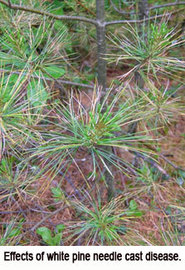 Many
woodland owners and others around the state noticed a recent browning of white
pines, followed by needle drop reminiscent of autumn. As one observer said,
“Golden needles are falling like snow!” The July 1
WoodsWiseWire included
a segment outlining the problem known as White Pine needle cast disease. Recent
rains have brought down most if not all the affected needles, leaving some
crowns green but a little thin looking, and leaving many to wonder if Maine’s
white pine trees are in danger.
Growing
Eastern white pine is generally a rewarding activity both ecologically and
economically. Eastern white pine is one
of the faster-growing and most valuable native conifers in Maine and, for this
reason, offers a great opportunity to observe forest growth and developmental
changes over a relatively short period of time.
But as with all living things, white pine is susceptible to a variety of
pest problems, including both insects and diseases. Woodlot owners and managers
growing white pine should become familiar with these principal pests so that if
problems arise, the problem can be identified quickly, and timely management
actions can be taken. Besides the needle cast, other diseases such as white
pine blister rust and Caliciopsis Canker
may be present. Insects that commonly cause problems for white pine include the
white pine weevil, the pine leaf adelgid, and the red turpentine beetle.
It’s
very important to remember that no one of these pests is an automatic killer of
pine trees. Rather, they all add stress to the viability of infested trees,
each in their own way. For instance, the needle cast reduces the amount of live
crown, thereby reducing the ability of a tree to perform photosynthesis and
store sugar (energy) for future growth, seed production and defense from other
pests.
Besides
insects and disease, other sources of stress on pine (and all trees really)
include site (too wet, too dry, not enough room for roots to grow); weather
(prolonged drought is probably the worst case); or mechanical damage from snow
plows, logging equipment, and the like. It’s usually an accumulation of
problems that weakens trees over time, until one last factor (perhaps red
turpentine beetles) delivers the final blow to a given tree.
While
all this may seem depressing to a woodland owner, keep in mind that most of our
forests have a healthy mixture of species and sites, and a range of individual
tree health and vigor. It is very unlikely that an entire stand or woodlot will
be devastated all at once. Keeping an eye on your woods, seeking professional
advice, and planning and carrying out practices such as thinning, weeding, and
(when needed) regeneration cutting.
These practices will greatly reduce the chance of any one pest becoming
a major problem. Active stewardship will help you reach your goals and
objectives for your land.
To
find out more, check out MFS
information Sheet # 24, Principal Disease and Insect Pests of White Pine in
Maine.
As
always, you
can call the Maine Forest
Service for more information or assistance at 1 800 367-0223 (in state)
or (207) 287-2791, or e-mail forestinfo@maine.gov
|